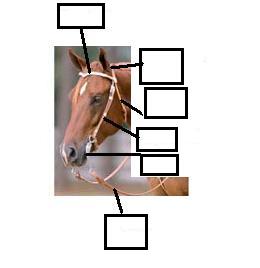1. Correct tacking up procedure (western tack). Put them in the right order.
Number from step 1 - step 4
Step ______ Return to near side and carefully reach under horse and grasp cinch and bring towards you (you may hook stirrup to horn on near side to allow for easy access to cinch).
Step ______ Saddle pad must be lying smoothly without wrinkles. Place saddle on pad, making sure not to disturb pad while placing saddle on top. Go to right side (off side) of horse and let cinch down from keeper and make sure saddle pad is lying correctly and smoothly under saddle. Step ______ Approach horse from its left side (also known as the near side). Standing near the horses shoulder (always making sure horse is aware of your position slowly place saddle pad (thick pad used under saddle) on horse's back, front of pad should be in front of withers. Step ______ Take latigo (strap that attaches girth to saddle on near side) down from keeper and run down through cinch ring. Bring latigo up through ring and down through ring again ~ slipping the buckle tongue through a hole in the latigo strap. Latigo strap should be snug.
2. Know correct tacking up procedure (hunt seat tack). True or False.Use T for true and F for false. _____ Horse should be loose. ______ Approach horse from its left side (also known as the near side). ______ Standing away from the horse's shoulder, throw saddle with saddle pad attached onto horse's back. ______ Always make sure that saddle pad is not wrinkled. ______ Still on near side attach girth to billet straps on highest holes, use the end of the girth that does not have elastic straps. ______ Attach girth to billet straps loosely. ______ Go to near side and tighten more snugly, the elastic straps will allow you to tighten girth more easily on near side.
3. Explain leads at lope/canter. Fill in the blanks.
As a horse travels at a lope or canter one front leg reaches out farther than the other. This is called the __________________. Horses traveling to the right should lead with their ______________ front leg. In addition the horse's hind right leg will reach _____________________ than the horse's left leg. A horse that is cantering on the correct lead in front while on the wrong lead behind is referred to as ___________________. If the rider intentionally wants to be on the "wrong" lead it is called ___________________. Counter-cantering can be requested in horsemanship and hunt seat equitation classes.cross-firing, counter-cantering, lead leg, right, further forward
4. Know the difference in a turn on the forehand and turn on the haunches. Fill in the blank.
Turn on hindquarter, Turn on forehand ________________________________ - Horse's front end is stationary while the hindquarters move, often used in hunt seat equitation, and trail classes ________________________________~ Horse's hind end is stationary while front end moves. Used in horsemanship, trail, and reining patterns (also referred to as spins, pivots, 90, 180, or 360 degree turns).
5. Know the parts of the bridle (hunt seat and western). Fill in with the correct letter.

Hunt seat bridle parts A. Reins
Western bridle parts A. Reins
B. Throatlatch B. Throatlatch C. Noseband or cavesson C. Bit D. Bit D. Cheekpiece E. Cheekpiece E. Browband F. Browband F. Crownpiece G. Crownpiece
6. Explain correct method of tying horse. True or False. Use T for true and F for false.
______ When tying a horse always use a halter and lead rope
______ never tie your horse when it has a bridle on.
______ Always tie your horse to a solid object intended for this purpose.
______ tie to anything that a horse could pull loose.
______ Never use a quick release knot.